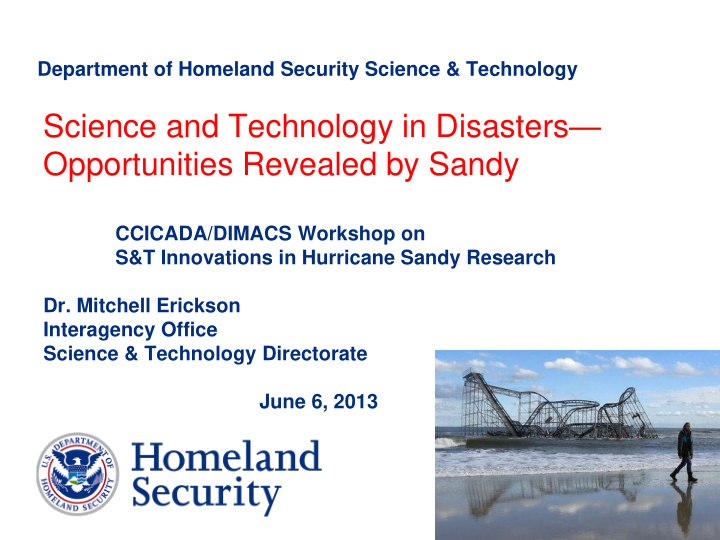



Department of Homeland Security Science & Technology Science and Technology in Disasters — Opportunities Revealed by Sandy CCICADA/DIMACS Workshop on S&T Innovations in Hurricane Sandy Research Dr. Mitchell Erickson Interagency Office Science & Technology Directorate June 6, 2013 1
The Lens of Hurricane Sandy o One of the most devastating storms in US history--$60B and counting o Sandy hit an area not frequently impacted by hurricanes. o Future: more more-violent weather? o Many lessons learned (re-learned?) Update building codes, laws and other issues that do not involve S&T S&T can contribute to a more resilient society. o Sandy is a lens to focus attention on capability gaps. o USA is implementing The National Preparedness Goal (PPD- 8): a strategic change to “whole community ” PPD 21: “Critical Infrastructure Security and Resilience”
PPD-8 The National Preparedness Goal o To have a secure and resilient Nation with the capabilities required across the whole community to prevent, protect against, mitigate, respond to, and recover from the threats and hazards that pose the greatest risk. 30 Mar2011 http://www.dhs.gov/presidential-policy-directive-8-national-preparedness http://www.whitehouse.gov/blog/2011/10/07/ppd-8-announcing-national-preparedness-goal o FEMA Implementation: A National Preparedness System Description; A series of National Frameworks and Federal Interagency Operational Plans; A National Preparedness Report; and A Campaign to Build and Sustain Preparedness o Sandy Observations: Innovative volunteer efforts Social media extensively used Many elderly died of hypothermia over several days Where can we save lives? Money? Heart ache? Jobs/Economy? 3
PPD-21 Critical Infrastructure Security and Resilience It is the policy of the United States to strengthen the security and resilience of its critical infrastructure against both physical and cyber threats. The Federal Government shall work with critical infrastructure owners and operators and SLTT entities to take proactive steps to manage risk and strengthen the security and resilience of the Nation's critical infrastructure, considering all hazards that could have a debilitating impact on national security, economic stability, public health and safety, or any combination thereof. These efforts shall seek to reduce vulnerabilities, minimize consequences, identify and disrupt threats, and hasten response and recovery efforts related to critical infrastructure. 12 Feb 13 http://www.whitehouse.gov/the-press-office/2013/02/12/presidential-policy-directive-critical-infrastructure-security-and-resil 4
PPD-21 Critical Infrastructure Security and Resilience-2 o FEMA Implementation: Develop a situational awareness capability that addresses both physical and cyber aspects of how infrastructure is functioning in near-real time Understand the cascading consequences of infrastructure failures Evaluate and mature the public-private partnership Update the National Infrastructure Protection Plan Develop comprehensive research and development plan http://www.dhs.gov/sites/default/files/publications/EO-PPD%20Fact%20Sheet%2012March13.pdf o Sandy Observations: Situational awareness could have been better Cascading consequences … no electricity, no fuel Public-private partnerships maturing R&D Plan…Today! 5
ONE MONTH LATER: Fires still smolder in the South Manoloking section of Brick Twp. Aerials of the Ocean County shore. Brick Twp, NJ 10/31/12 (Andrew Mills/The Star-Ledger)
• Lake Borgne Surge Barrier Hoboken, NJ
•
ConEd Substation @14 th St & FDR
TRANSCOM Report 3 Nov 2012 11
12
13
Masdar UAE
Consumer Electronics 350 2001 2010 (millions) 170 80 40 31 27 24 22 18 16 9 7 0.9 0.5 0.2 0.1 0 0 0 0 Invent.& Technol. Winter 2010
Capability Gap Categories Infrastructure hardening Models and assessment tools Water Control Electric Power Other Lifeline Infrastructure Resilience Training and Exercises Analysis Communications Big Data Other
OSTP Sandy Task Force o Federal Review & Permitting o Infrastructure o Housing o Insurance o Small Business o Capacity Building o Data Sharing 17
Challenges for Disasters o Water management o Make a compelling case for resilient infrastructure o Work with, not against, Mother Nature o Monitoring and diagnostics of infrastructure health o Communications in challenged environments o Informing the community o Risk models that include direct and indirect costs (quality of life…) o The data deluge 18
Grand Challenges for Disasters o Cut the cost of disaster management in half o How do we want our community to look in 50 years? 19
Mitch Erickson Science Advisor Interagency Office Department of Homeland Security Science and Technology Directorate Mitchell.erickson@dhs.gov
Recommend
More recommend